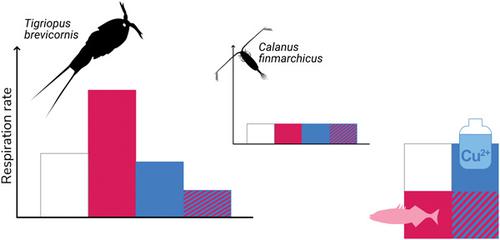当前位置:
X-MOL 学术
›
Environ. Toxicol. Chem.
›
论文详情
Our official English website, www.x-mol.net, welcomes your
feedback! (Note: you will need to create a separate account there.)
Contrasting Effects of Predation Risk and Copper on Copepod Respiration Rates.
Environmental Toxicology and Chemistry ( IF 3.6 ) Pub Date : 2020-06-17 , DOI: 10.1002/etc.4804 Torben Lode 1 , Jan Heuschele 1 , Tom Andersen 1 , Josefin Titelman 1 , Ketil Hylland 1 , Katrine Borgå 1
Environmental Toxicology and Chemistry ( IF 3.6 ) Pub Date : 2020-06-17 , DOI: 10.1002/etc.4804 Torben Lode 1 , Jan Heuschele 1 , Tom Andersen 1 , Josefin Titelman 1 , Ketil Hylland 1 , Katrine Borgå 1
Affiliation

|
Natural biotic and anthropogenic stressors can interact to alter contaminant toxicity. Energetic restrictions are potential mechanisms causing this pattern. To identify processes underlying observed effects of predation risk and copper (Cu) on delayed copepod age at maturity, we examined how these 2 stressors affect respiration rates. We tested 2 very different copepod species: the large, pelagic calanoid Calanus finmarchicus and the small, semibenthic harpacticoid Tigriopus brevicornis. Adult individuals were exposed for 12 h to the treatments: predation risk, Cu (23 µg L−1), combined predation risk and Cu (23 µg L−1), or control. Oxygen concentrations were monitored continuously. The 2 species differed in their responses. We found no clear effects of either stressor in C. finmarchicus. In T. brevicornis, predation risk increased respiration rates, whereas Cu alone had little impact. In contrast, combined exposure to predation risk and Cu interacted to reduce respiration rates to less than expected. We further observed an effect of sex because female‐biased T. brevicornis replicates were more sensitive to both predation risk (increased respiration rates) and Cu exposure (reduced respiration rates). The present study provides further evidence that predation risk can interact with copepod responses toward Cu exposure. Interactive effects of biotic stressors ought to be considered to improve future marine environmental monitoring. Environ Toxicol Chem 2020;39:1765–1773. © 2020 The Authors. Environmental Toxicology and Chemistry published by Wiley Periodicals LLC on behalf of SETAC.
中文翻译:

捕食风险和铜对Co足类动物呼吸速率的对比影响。
天然生物和人为压力源可以相互作用来改变污染物的毒性。能量限制是导致这种模式的潜在机制。为了确定潜在的捕食风险和铜(Cu)对co足类动物成熟延迟的影响的过程,我们研究了这两种压力如何影响呼吸速率。我们测试了2种非常不同的co足类物种:大型中上层类颅骨Calaus finmarchicus和小型半底类类立足类拟南芥Tigriopus brevicornis。成年个体接受以下治疗12小时:捕食风险,Cu(23 µg L -1),联合捕食风险和Cu(23 µg L -1))或控制。连续监测氧气浓度。这两种物种的反应不同。我们没有发现任何应激源对C. finmarchicus有明显影响。在短角锥虫中,捕食风险增加了呼吸频率,而单独使用铜影响不大。相比之下,捕食风险和铜的联合暴露会降低呼吸频率,使其低于预期。我们进一步观察到了性的影响,因为女性偏爱的短锥T.复制品对捕食风险(呼吸频率增加)和铜暴露(呼吸频率降低)都更加敏感。本研究提供了进一步的证据,表明捕食风险可能与co足类动物对铜暴露的反应相互作用。应该考虑生物应激源的相互作用,以改善未来的海洋环境监测。2020年《环境毒理学》; 39:1765–1773。©2020作者。Wiley Periodicals LLC代表SETAC发布的《环境毒理学和化学》。
更新日期:2020-08-25
中文翻译:

捕食风险和铜对Co足类动物呼吸速率的对比影响。
天然生物和人为压力源可以相互作用来改变污染物的毒性。能量限制是导致这种模式的潜在机制。为了确定潜在的捕食风险和铜(Cu)对co足类动物成熟延迟的影响的过程,我们研究了这两种压力如何影响呼吸速率。我们测试了2种非常不同的co足类物种:大型中上层类颅骨Calaus finmarchicus和小型半底类类立足类拟南芥Tigriopus brevicornis。成年个体接受以下治疗12小时:捕食风险,Cu(23 µg L -1),联合捕食风险和Cu(23 µg L -1))或控制。连续监测氧气浓度。这两种物种的反应不同。我们没有发现任何应激源对C. finmarchicus有明显影响。在短角锥虫中,捕食风险增加了呼吸频率,而单独使用铜影响不大。相比之下,捕食风险和铜的联合暴露会降低呼吸频率,使其低于预期。我们进一步观察到了性的影响,因为女性偏爱的短锥T.复制品对捕食风险(呼吸频率增加)和铜暴露(呼吸频率降低)都更加敏感。本研究提供了进一步的证据,表明捕食风险可能与co足类动物对铜暴露的反应相互作用。应该考虑生物应激源的相互作用,以改善未来的海洋环境监测。2020年《环境毒理学》; 39:1765–1773。©2020作者。Wiley Periodicals LLC代表SETAC发布的《环境毒理学和化学》。











































 京公网安备 11010802027423号
京公网安备 11010802027423号